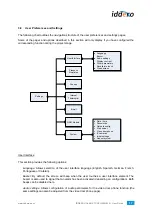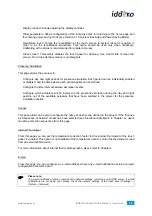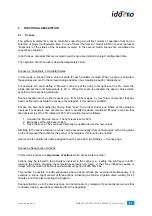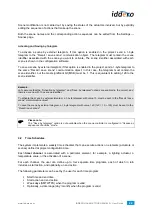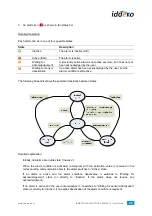
www.iddero.com
IDDERO HCx-KNX TOUCH PANELS – User Guide
25
-
If an alarm is waiting for acknowledgement or deactivation, and a new telegram with the activation
value is received in the corresponding communication object, the alarm is triggered again and
goes back to “Active” state.
-
If an alarm is waiting for deactivation, and this does not occur for a certain configurable period of
time, the alarm is automatically re-triggered.
Bypass Function
The bypass function temporarily disables the alarm subsystem. While the bypass function is enabled,
no alarms are processed.
When the bypass function is disabled, any alarms that do not require explicit deactivation will
automatically return to inactive state. Alarms requiring explicit deactivation will switch to active or
inactive state, depending on the current value of the corresponding communication object.
When the bypass function is enabled, the LED status indicator turns red and an icon (
) is shown in
the status bar.
Alarm Log
The system keeps an alarm log that holds information about the latest 100 security events. This log is
kept in persistent storage and includes the time, date, and description of each event.
The following events are logged:
System
startup
Alarm
activation
Alarm acknowledgment (for alarms requiring acknowledgment)
Alarm deactivation (for alarms not requiring acknowledgment)
Enabling and disabling the bypass function
Enabling and disabling presence simulation
Clearing the alarm log
4.4 Presence
Simulation
The presence simulation function performs different actions on a set of devices and appliances, thus
creating the impression that the house is occupied during holidays or prolonged absence periods.
The communication objects (actuators) involved in the presence simulation process are defined at
project configuration time. During the presence simulation, the system periodically sends telegrams
containing pseudo-random values to these actuators.
Two different simulation periods can be defined – a day period and a night period. For each period,
users can define the start and end times, as well as which actuators will be involved, out of the ones
that were defined at project configuration time. This makes it possible to configure the system to act
differently during the day and at night. For example, the presence simulation function can be made to
operate on the house lights at night time and on the blinds during the day.
The event interval can also be configured by the user. This parameter defines time elapsed between
two consecutive events during presence simulation.







